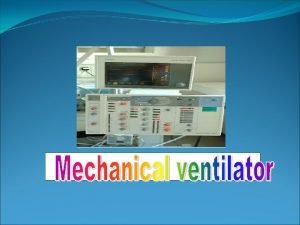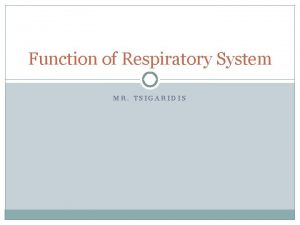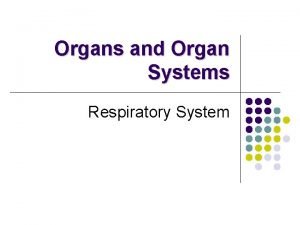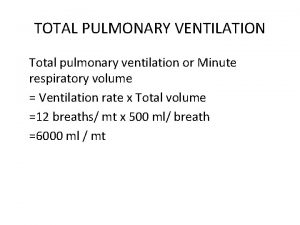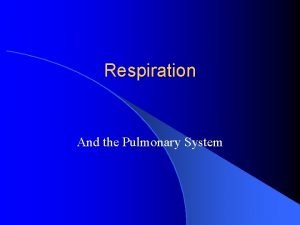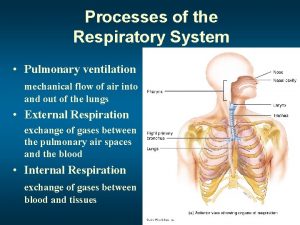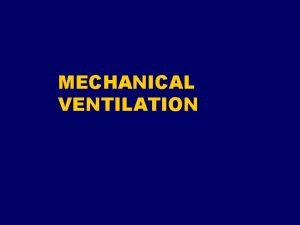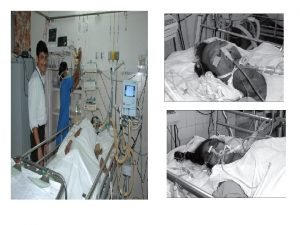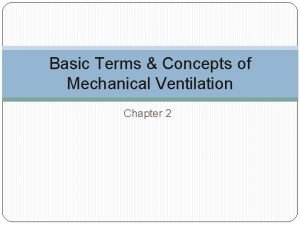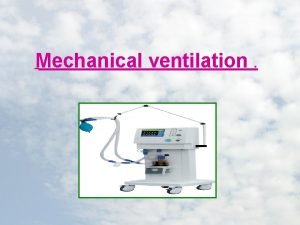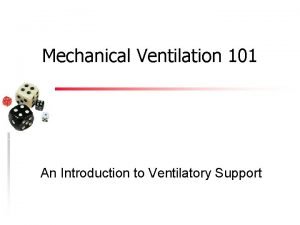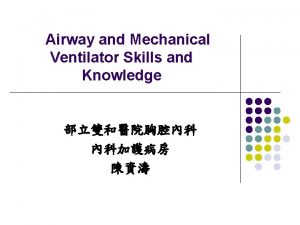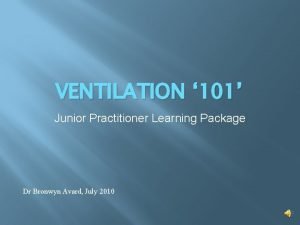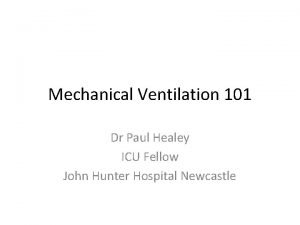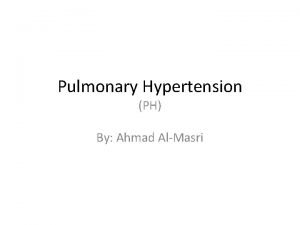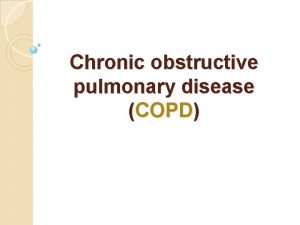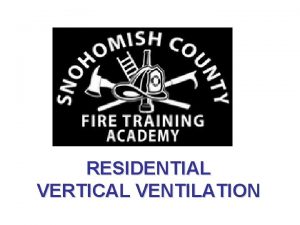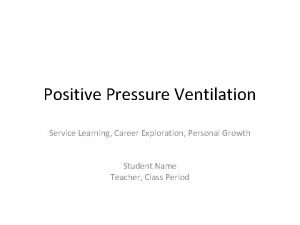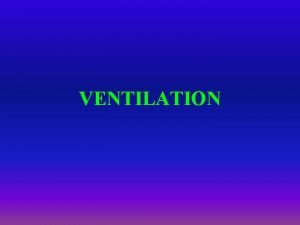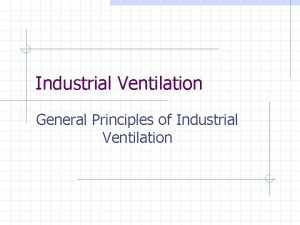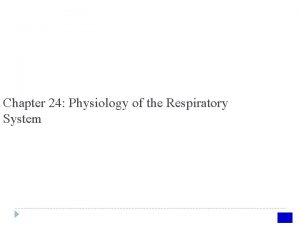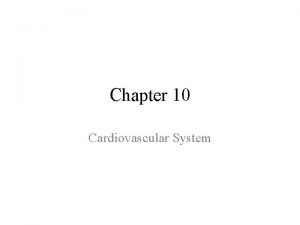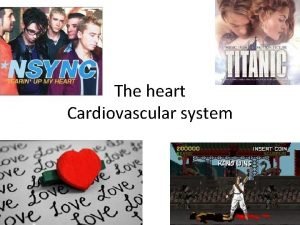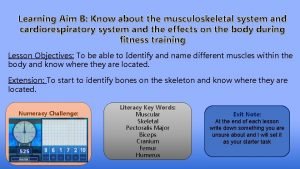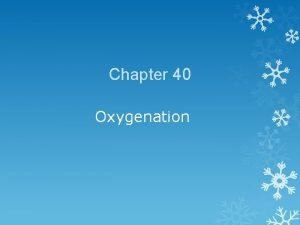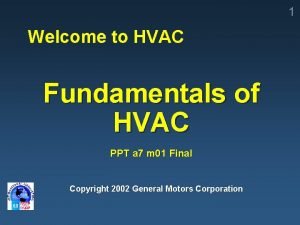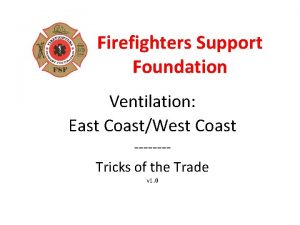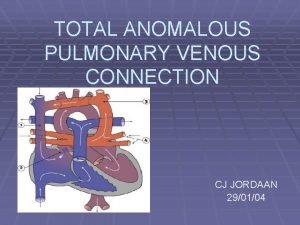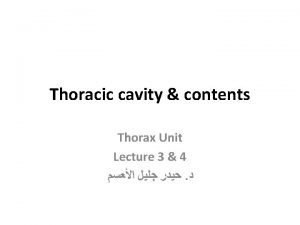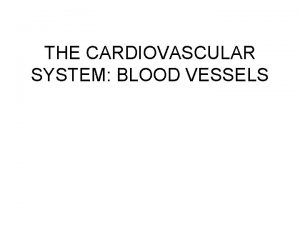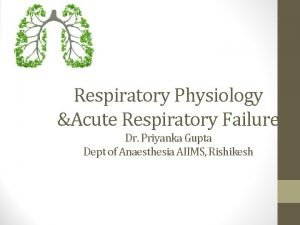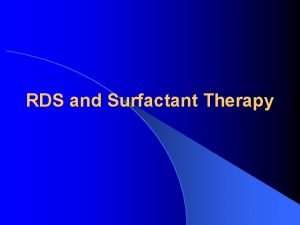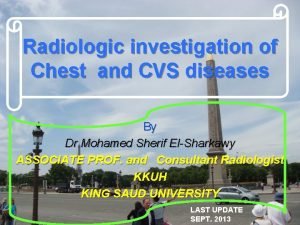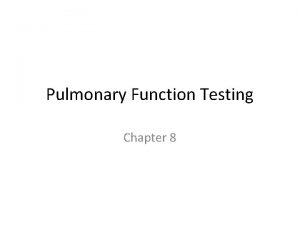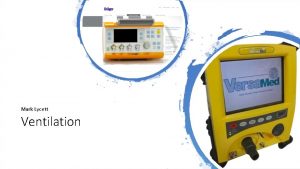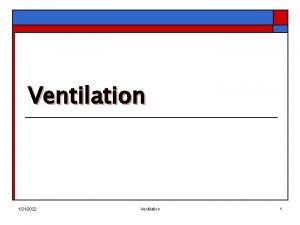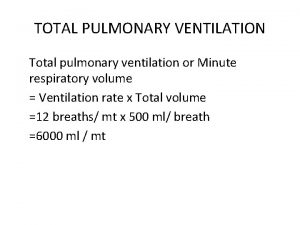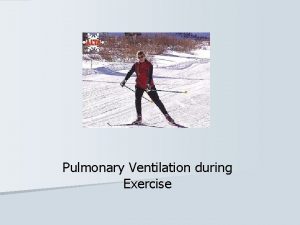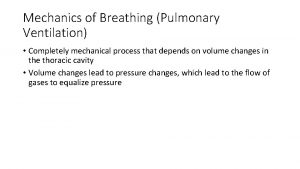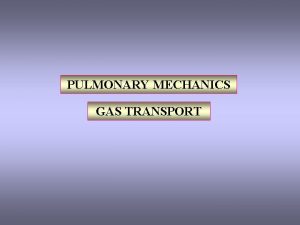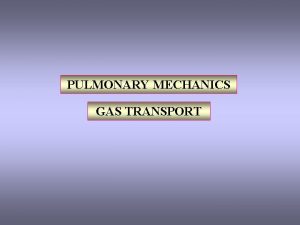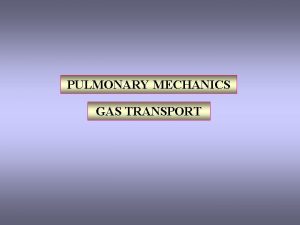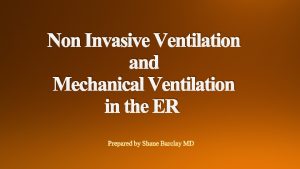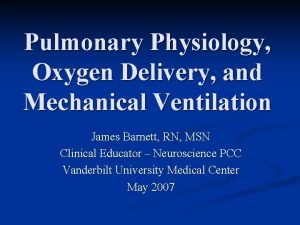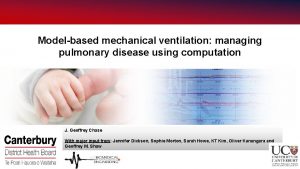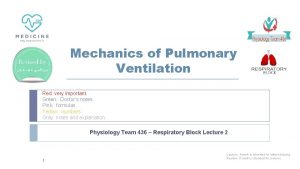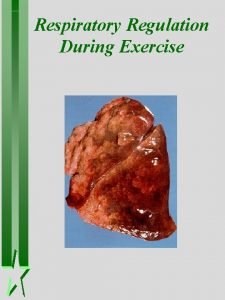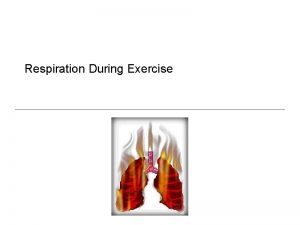Pulmonary Mechanics and Graphics during Mechanical Ventilation Definition















































- Slides: 47

Pulmonary Mechanics and Graphics during Mechanical Ventilation

Definition • Mechanics: • Expression of lung function through measures of pressure and flow: • Derived parameters: volume, compliance, resistance, work • Graphics: • Plotting one parameter as a function of time or as a function of another parameter • P-T, F-T, V–T F-V, P-V

Objectives • Evaluate lung function • Assess response to therapy • Optimize mechanical support

Exponential Decay y 37 13. 5 5 y = y 0. e (-t / TC) TC

Exponential Rise y 95 86. 5 63 y = yf . (1 -e (-t / TC)) TC

Time Constant ( ) • Time required for rise to 63% • Time required for fall to 37% • In Pul. System = Compliance • Resistance = (0. 05 to 0. 1) • 10 = 0. 5 – 1 sec

Airway Pressure • Equation of Motion • . Paw = V(t) / C + R V(t) + PEEPi

Airway Pressure Sites of Measurement • Directly at proximal airway • At the inspiratory valve • At the expiratory valve

Airway Pressure Sites of Measurement • 1) 2) 3) Directly at proximal airway The best approximation Technical difficulty Hostile environment

Airway Pressure Sites of Measurement • Directly at proximal airway • At the inspiratory valve To approximate airway pressure during expiration

Airway Pressure Sites of Measurement • Directly at proximal airway • At the inspiratory valve • At the expiratory valve To approximate airway pressure during inspiration

A typical airway pressure waveform Volume ventilation PIP Linear increase Initial rise PPlat End-exp. Pause (Auto-PEEP)

Peak Alveolar Pressure (Pplat) • Palv can not be measured directly • If flow is present, during inspiration: Paw > Pplat Measurement by end-inspiratory hold

Peak Inspiratory Pressure (PIP) PPlat PZ Pressure at Zero Flow

Peak Alveolar Pressure (Pplat) Uses • Prevention of overinflation Pplat 34 cm. H 2 O • Compliance calculation CStat = VT / (PPlat – PEEP) • Resistance calculation RI = (PIP – PPlat) / VI

Auto-PEEP • Short TE air entrapment • Auto-PEEP = The averaged pressure by trapped gas in different lung units • TE shorter than 3 expiratory time constant • So it is a potential cause of hyperinflation

Auto-PEEP Effects • Overinflation • Failure to trigger • Barotrauma

Auto-PEEP Measurement technique

Auto-PEEP Influencing factors • Ventilator settings: RR – VT – TPlat – I: E – TE • Lung function: Resistance – Compliance • auto-PEEP = VT / (C · (e. Te/ – 1)) Te = Exp. Time , = Exp. Time constant , C = Compliance

Esophageal Pressure • • In the lower third(35– 40 cm, nares) Fill then remove all but 0. 5 – 1 ml Baydur maneuver, cardiac oscillation Pleural pressure changes Work of breathing Chest wall compliance Auto-PEEP

Esophageal Pressure Auto-PEEP Measurement • Airway flow & esophageal pressure trace • Auto-PEEP = Change in esophageal pressure to reverse flow direction • Passive exhalation

Esophageal Pressure Auto-PEEP Measurement Flow Peso

Flow Inspiratory Volume ventilation • Value by Peak Flow Rate button • Waveform by Waveform select button

Flow Inspiratory Pressure ventilation · • Value : V = ( P / R) · (e-t / ) • Waveform:

Flow Expiratory • Palv , RA , · • V = –(Palv / R) · (e-t / )

Flow waveform application • Detection of Auto-PEEP 1) Expiratory waveform not return to baseline (no quantification) 2) May be falsely negative Flow at endexpiration

Flow waveform application • Dips in exp. flow during assisted ventilation or PSV: Insufficient trigger effort Auto. PEEP Inspiratory effort

Volume • Measurement: Integration of expiratory flow waveform

Compliance • VT divided by the pressure required to produce that volume: C = V / P = VT / (Pplat – PEEP) • Range in mechanically ventilated patients: 50 – 100 ml/cm. H 2 O • 1 / CT = 1 / Ccw + 1 / CL

Chest wall compliance (Ccw) • Changes in Peso during passive inflation • Normal range: 100 – 200 ml/cm. H 2 O 400 ml

Chest wall compliance Decrease • • • Abdominal distension Chest wall edema Chest wall burn Thoracic deformities Muscle tone

Chest wall compliance Increase • Flail Chest • Muscle paralysis

Lung compliance • VT divided by transpulmonary pressure (PTP) • PTP = Pplat – Peso • Normal range : 100 – 200 ml/cm. H 2 O 30 cm. H 2 O PTP = Pplat – Peso= 30 – 17 = 13 17 cm. H 2 O

Lung compliance Decrease v Pulmonary edema v ARDS v Pneumothorax v Consolidation v Atelectasis v Pulmonary fibrosis v Pneumonectomy v Bronchial intubation v Hyperinflation v Pleural effusion v Abdominal distension v Chest wall deformity

Airway resistance • Volume ventilation · RI = (PIP – PPlat) / VI · RE = (Pplat – PEEP) / VEXP • Intubated mechanically ventilated RI 10 cm. H 2 O/L/sec RE > R I

Airway resistance Increased • Bronchospasm • Secretions • Small ID tracheal tube • Mucosal edema

Mean Airway Pressure • • Beneficial and detrimental effects of IPPV Direct relationship to oxygenation Time average of pressures in a cycle Pressure ventilation (PIP – PEEP) · (TI / Ttot) + PEEP • Volume ventilation 0. 5 · (PIP – PEEP) · (TI / Ttot) + PEEP

Mean Airway Pressure 14 cm. H 2 O

Mean Airway Pressure Typical values • Normal lung : 5 – 10 cm. H 2 O • ARDS : 15 – 30 cm. H 2 O • COPD : 10 – 20 cm. H 2 O

Pressure-Volume Loop • Static elastic forces of the respiratory system independent of the dynamic and viscoelastic properties • Super-syringe technique • Constant flow inflation • Lung and chest wall component • Chest wall PV: Volume vs. Peso • Lung PV: Volume vs. PTP

PV Loop • Normal shape: Sigmoidal • Hysteresis: Inflation vs. deflation • In acute lung injury: Initial flat segment – LIP – Linear portion – UIP • LIP = Closing volume in normal subjects • UIP = Overdistension • Best use of PV loop: To guide ventilator management PEEP > LIP , Pplat < UIP

Normal PV Loop

PV Loop in Acute Lung Injury UIP LIP

PEEP > LIP , Pplat < UIP • • • Reduce ventilator associated lung injury Prevention of overinflation Increased recruitment of collapsed units Lower incidence of barotrauma Higher weaning rate Higher survival rate

PV Loop Role of chest wall component • • Effect on LIP and UIP PV loop for lung alone: Use of Peso LIP underestimates the necessary PEEP Better results with PEEP set above LIP on deflation PV loop rather inflation

Volume Ventilation Parameters Interaction Run VVPI Program

 Mechanical ventilator modes
Mechanical ventilator modes Pulmonary ventilation consists of two cyclic phases, , and
Pulmonary ventilation consists of two cyclic phases, , and Windpipe cells
Windpipe cells Respiratory membrane
Respiratory membrane Physiology of respiration
Physiology of respiration Types of respiration
Types of respiration Pulmonary ventilation
Pulmonary ventilation Positive end expiratory pressure
Positive end expiratory pressure Pressure support ventilation ppt
Pressure support ventilation ppt Transairway pressure
Transairway pressure Tactical ventilation
Tactical ventilation How negative pressure is created
How negative pressure is created Pressure support ventilation
Pressure support ventilation Minute ventilation
Minute ventilation Malampti
Malampti Ventilation learning package
Ventilation learning package Dr paul healey
Dr paul healey Graphic monitor and workstation in computer graphics
Graphic monitor and workstation in computer graphics Computer graphics introduction ppt
Computer graphics introduction ppt Actual mechanical advantage vs ideal mechanical advantage
Actual mechanical advantage vs ideal mechanical advantage Definition of pulmonary hypertension
Definition of pulmonary hypertension Pulmonary hypertension definition
Pulmonary hypertension definition Copd exacerbation nursing management
Copd exacerbation nursing management Vertical ventilation techniques
Vertical ventilation techniques Vertical ventilation definition
Vertical ventilation definition Lev system design
Lev system design Types of industrial ventilation
Types of industrial ventilation Pulmonary gas exchange and transport diagram
Pulmonary gas exchange and transport diagram Pulmonary artery and aorta
Pulmonary artery and aorta Bronchioles
Bronchioles Aorta inferior vena cava
Aorta inferior vena cava Aorta and pulmonary artery
Aorta and pulmonary artery Structure of the heart
Structure of the heart The circulatory system
The circulatory system Pulmonary volumes and capacities
Pulmonary volumes and capacities Factors affecting oxygenation slideshare
Factors affecting oxygenation slideshare Refrigeration and air conditioning ppt
Refrigeration and air conditioning ppt Ventilation and warming florence nightingale
Ventilation and warming florence nightingale 798 ventilation cut
798 ventilation cut Tapvc
Tapvc Thoracic cavity
Thoracic cavity Circulatory pathways
Circulatory pathways Neurogenic shock pathophysiology
Neurogenic shock pathophysiology Tricuspid valve
Tricuspid valve Pulmonary toilet
Pulmonary toilet Pulmonary surfactant function
Pulmonary surfactant function Rib anatomy anterior
Rib anatomy anterior Pft loops
Pft loops
